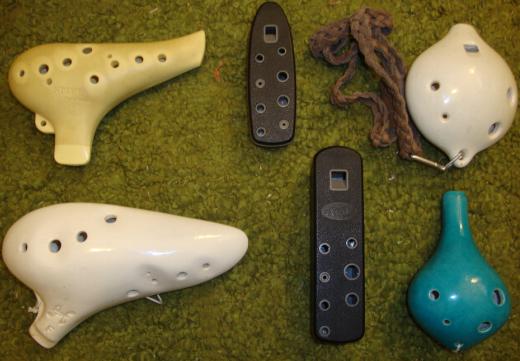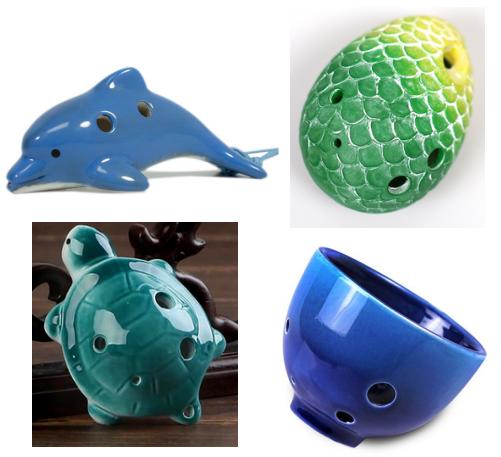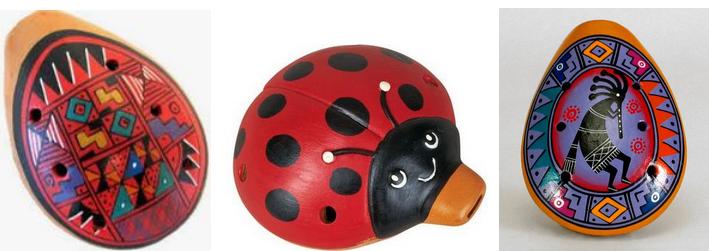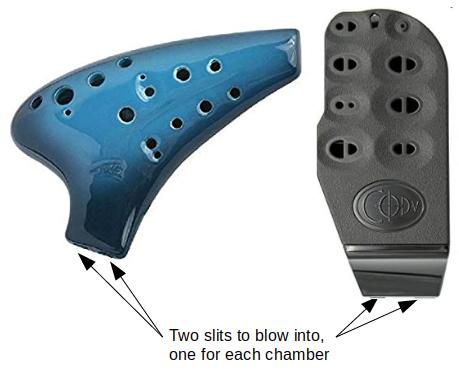Beginner's Guide to the Ocarina
One benefit to fluting is that it enables you to play so many different instruments.
Take the ocarina, for example. If you play concert flute, you can play the “oc” as soon as you pick one up.
And, as this video shows, ocarinas sound intriguingly different. That's because they're a kind of vessel flute — an enclosed chamber with fingering holes.
They're also more portable and durable than metal flutes. I wouldn't dream of taking my C flute to the beach or on a camping trip. But an oc? Of course.
Finally, they cost a pittance. At only $20 to $40 apiece, you can amass an entire collection for less than the cost of a single Boehm.
This article tells you everything you need to know to get started with ocarinas.
Shapes and Materials
Ocarinas come in three main shapes:
- Transverse, also called submarine or sweet potato
- Inline
- Pendant, also called seedpod
They're made of several different materials:
- Ceramic, also known as clay, baked clay, or porcelain
- Plastic
- Wood
This photo shows a few of the possibilities:

To the left are two transverse oc's. The yellow one is plastic, while the white one below it is ceramic.
In the middle, shaped like TV remotes, are two plastic inlines. You play them extended straight out from your mouth.
To the right are two pendants or seedpods. Both are ceramic. Many small pendants come with a lanyard or necklace so that you can wear them around your neck.
Fun Seedpods
Some pendants come in cute shapes, and many flute players enjoy collecting them. Check out the dolphin, dragon's egg, turtle, and tea cup you can both play tunes on and drink from:

All the oc's in these photos play beautifully. But beware! Some eye-catching specimens do not. You can tell whether an oc is playable by inspecting its fingering holes. If all the holes are the same size, it's strictly for your display shelf. Playable ocarinas have differently-sized top holes.
Look closely, and you'll see that these oc's may sound a few random notes but are not playable musical instruments:

The Basics
Here are some key facts about ocarinas:
Key
You can buy an oc in almost any key. Most are either soprano, alto, tenor, or bass.
Altos and basses are in the key of C, that is, their lowest note is C. The bass sounds one octave lower than the alto.
Similarly, the soprano and tenor are typically in the key of G. The tenor sounds one octave lower than the soprano.
Size
Smaller instruments are usually louder and cost less. Larger oc's are usually softer-spoken and cost more.
Transverses and Inlines versus Pendants
Transverse and inlines finger much like any simple flute: you ascend the scale by progressively removing your fingers from the holes.
Pendants finger differently. They don't follow such a simple pattern, so you must memorize the notes. Because of this, many consider transverses and inlines a bit easier to learn to play than pendants.
6-hole and 4-hole Seedpods
Pendants or seedpods come in 6-hole and 4-hole varieties. 4-holers have just four holes on top, while 6-holers add two thumb holes on the underside of the instrument. 6-holers play more notes than 4-holers, and are therefore much more popular.
Ceramic versus Plastic
Ceramic is traditional, so some purists favor it. Others dispute that, and note that if you drop a plastic oc it probably won't break, whereas dropping a ceramic one can be disastrous.
Differences
Ocarinas are limited compared to concert flutes in several ways.
First off, they're not tunable. They don't have a movable head joint or mouthpiece. About all you can do to get in tune with a group is make sure your instruments are all at the same temperature before starting, and then blow either harder or softer to raise or lower the pitch a smidgen.
Second, not all oc's play every note in tune. These are folk instruments, so their quality varies from outstanding to abysmal.
Some oc's are not in tune with standard concert pitch — a C-major oc might not actually start its scale with an accurate C.
Others start on an accurate base pitch, but are not in tune with themselves. In other words, some notes don't sound at the proper relative pitches to the base note.
And some are in tune except for one or two notes. The out-of-tune notes are typically the highest or lowest ones, or sometimes sharps and flats.
How do you know the oc you want to buy is in tune?
If you can try the oc before you buy it, you can personally verify that it's tuned. Listen to sound samples if you buy online.
Otherwise, your best assurance that your oc will be in tune is to purchase one of the popular oc's made by a top-rated manufacturer and sold through a reputable vendor. (I'll give some recommendations below.) Stay away from the homemade instrument sold on Etsy or the cute little collectible. Those are fun but they're risky for a first purchase.
Limited Range
Whereas a concert flute can play 3 and a half octaves, ocarinas only span this range:
| Number of Holes | Whole Notes |
|---|---|
| 12-hole transverse | 13 |
| 10-hole transverse or inline | 11 |
| 6-hole seedpod | 10 |
| 4-hole seedpod | 8 |
The range includes all sharps and flats. It's enough to play any tune you like, but sometimes you'll have to transpose a wide-ranging song into an appropriate key to play it.
Multi-chamber ocarinas overcome these range limitations. They can play either two or three full octaves. The way they work is that they have either two or three different enclosed chambers, each set to a different pitch range. You pick the range you want by selecting which slit to blow into, and also moving your fingers to the appropriate set of finger holes.

If you're new to ocarinas, start with a traditional single-chamber oc. I only mention these advanced oc's so that you're aware of the possibilities.
A Warning About Terminology
Not only are oc's famously un-standardized, but so is their terminology.
For example, nearly everyone calls the most common size of ocarina the Alto C. Its lowest note is the same C as the soprano recorder (C5).
But a few call this instrument a Tenor, most notably the major US vendor STL Ocarinas.
The best way to keep this straight is to verify that an ocarina is labeled a “C major” ocarina. If so, it's an Alto C, even if someone occasionally calls it a Tenor. (Bass ocarinas are also in C major, but you won't get confused because they're big and are always labeled “bass”.)
Buying Your First Oc
Given the great variety of ocarinas available, which should you buy for your first one? Nearly all musicians start with a 12-hole transverse Alto C. This instrument is keyed to C major, with its lowest note the same as the soprano recorder.
The transverse Alto C is a good first purchase because it's the single most popular oc. It fingers intuitively, plays the widest range of notes, and plays sheet music written for other instruments in C, such as the soprano recorder. Plus, you can easily find a quality instrument that plays in tune.
What brand should you buy? Hard to believe, but it's not always easy to figure out who makes any particular ocarina! Many of the biggest ocarina sellers — trusted vendors like Songbird Ocarina, STL Ocarina, and Stein Ocarina — often don't tell you who makes the oc's they sell. To add to the confusion, they may both import oc's and manufacture their own.
Since sellers don't always identify manufacturers, the only way to find out is to do some googling. By cross-checking websites, you can usually determine an oc's maker. Do your own research, but I've found consistent quality in name brands like Focalink and Night by Noble. OcarinaWind and TNG also make fine instruments, but avoid their lowest-priced offerings.
Here are three 12-hole transverse Alto C's that are top-rated by reviewers at Amazon:

From left to right, they are the Focalink plastic, OcarinaWind's Forest Whisperer in ceramic, and the Night by Noble plastic.
Conclusion
While ocarinas are among the easiest instruments to learn to play, it can be difficult to make a good first purchase.
My advice is to read reviews and listen to sound samples to familiarize yourself with what's out there. Then buy a name brand transverse alto C in either plastic or ceramic from a trusted seller. Check out those I've listed above. You'll invest only $30 to $40, and there's very little chance you'll go wrong.
Resources
For sound samples and reviews:
To post questions and find community:
About the Author
Howard Fosdick is a computer scientist who once played concert woodwinds but today concentrates on folk flutes. You might enjoy his other articles comparing ocarinas, recorders, tin whistles, and Native American flutes or tonettes, song flutes, and flutophones. He receives no compensation for any recommendations.